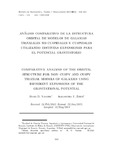Mostrar el registro sencillo del ítem
Comparative analysis of the orbital structure for non–cuspy and cuspy triaxial models of galaxies using different expansions of the gravitational potential
Análisis comparativo de la estructura orbital de modelos de galaxias triaxiales no cuspidales y cuspidales utilizando distintas expansiones para el potencial gravitatorio
| dc.creator | Navone, Hugo D. | |
| dc.creator | Zorzi, Alejandra F. | |
| dc.date.accessioned | 2015-05-19T19:09:26Z | |
| dc.date.available | 2015-05-19T19:09:26Z | |
| dc.date.issued | 2013-08-29 00:00:00 | |
| dc.identifier.citation | http://revistas.ucr.ac.cr/index.php/matematica/article/view/11664 | |
| dc.identifier.issn | ||
| dc.identifier.uri | https://hdl.handle.net/10669/13038 | |
| dc.description.abstract | One way to create models of elliptical galaxies is to start from a system of particles with a suitable distribution and to follow its evolution with an N-body code until it reaches equilibrium. In previous works we used the code of L.A. Aguilar to generate non-cuspy and cuspy models, the latter giving a better representation of elliptical galaxies. However, the method proposed by Hernquist and Ostriker is more suitable for the cases with central cusps, because it uses an expansion of the potential in radial functions that already reflects the cuspy character. Here we consider two models, one non-cuspy and another cuspy, obtained with the method of Aguilar and whose potentials we now fit with the Hernquist and Ostriker expansion. We obtained the corresponding variational equations and we used them to determine the Lyapunov exponents of orbits already investigated with the method of Aguilar and to separate the chaotic ones. We classified the regular orbits through the analysis of their orbital frequencies. Here we present a comparison of the results obtained with the two methods for both types of orbits. | |
| dc.description.abstract | Un método para generar modelos de galaxias elípticas consiste en partir de un sistema de partículas con una configuración adecuada y seguir su evolución con un código de N-cuerpos hasta que alcanza el equilibrio. En trabajos anteriores hemos utilizado el código de L.A. Aguilar para generar modelos tanto no cuspidales como cuspidales, ofreciendo los segundos una mejor representación de las galaxias elípticas. Sin embargo, el método propuesto por Hernquist & Ostriker es más adecuado para los casos con cúspides centrales, puesto que utiliza una expansión del potencial en funciones radiales que ya tiene caracter cuspidal. Aquí consideramos dos modelos, uno no cuspidal y otro cuspidal, obtenidos con el método de Aguilar y cuyos potenciales ajustamos ahora con la expansión de Hernquist & Ostriker. Obtuvimos las ecuaciones variacionales correspondientes y las empleamos para determinar los exponentes de Lyapunov de órbitas ya estudiadas con el método de Aguilar y separar las caóticas. Las ́orbitas regulares las clasificamos mediante el análisis de sus frecuencias orbitales. Presentamos una comparación de los resultados obtenidos con los dos métodos para ambos tipos de órbitas. | |
| dc.format.extent | 243-255 | |
| dc.relation.ispartof | Revista de Matemática: Teoría y Aplicaciones Vol. 20 Núm. 2 | |
| dc.title | Comparative analysis of the orbital structure for non–cuspy and cuspy triaxial models of galaxies using different expansions of the gravitational potential | |
| dc.title | Análisis comparativo de la estructura orbital de modelos de galaxias triaxiales no cuspidales y cuspidales utilizando distintas expansiones para el potencial gravitatorio | |
| dc.type | artículo original | |
| dc.date.updated | 2015-05-19T19:09:27Z | |
| dc.language.rfc3066 | es | |
| dc.identifier.doi | 10.15517/rmta.v20i2.11664 |


